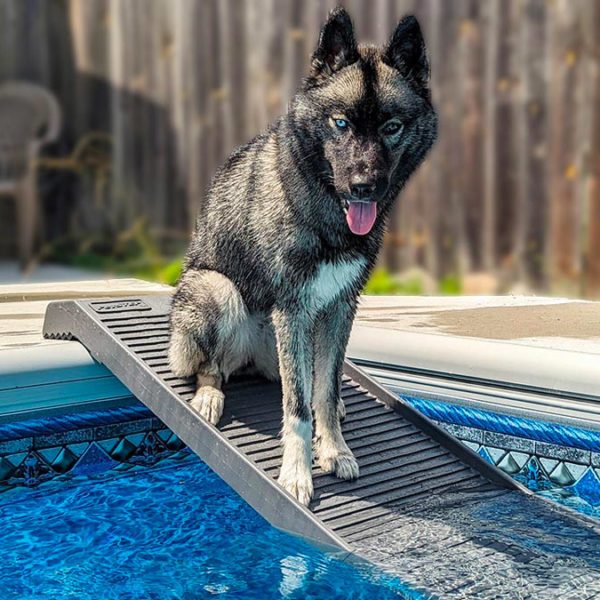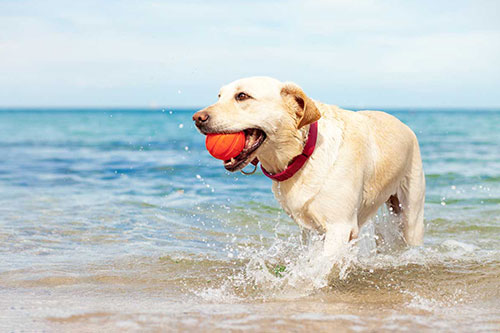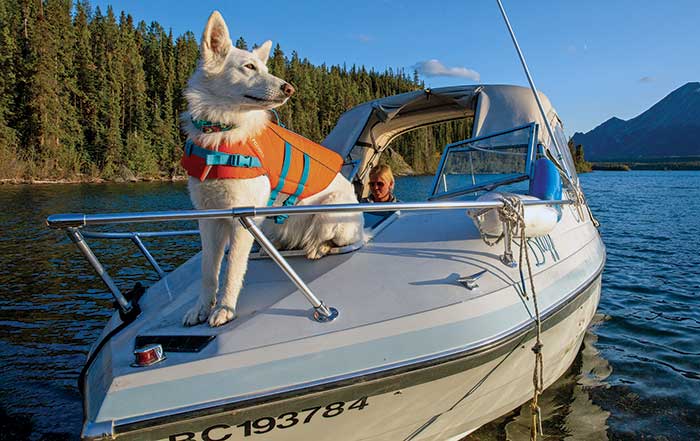Dog Water Safety Tips: Pools, Boats, Lakes, and Oceans

Table of Contents
Summer's here, and the call of the water is strong for us and our furry companions. But before you hit the beach, pool, or lake with your pup, it's crucial to prioritize their safety.
Dogs, regardless of breed, can face hidden dangers in all kinds of water environments, from pools to oceans.
This guide will help you navigate potential hazards of water for dogs. By familiarizing yourself with the specific risks around water, you can ensure a safe summer for your pet.
🔑 Key Takeaways:
-
Safety and supervision are top priorities for dogs around water
-
Pools, boats, rivers/lakes, and oceans all carry risks you must be aware of
-
Before heading to the water, know the area you are taking your dog to
-
Make sure they are comfortable around water, and always bring a well-fitted life jacket
Dogs and Swimming Pool Safety
Most dogs are very good swimmers and love to enjoy the pool on a hot summer day, just like we do. However, it's advised to prep your swimming pool with common safety best practices and pet-friendly items such as:
Pool Fences and Alarms
A fenced-in pool provides the most safety but can still pose a threat to your dog. To maximize safety, consider installing a pool alarm system that alerts you when your pet enters the water.
Pool Ramps and Stairs
Make sure your dog has a clear and easy entrance and exit to the pool. Installing pet-friendly stairs or a ramp and familiarizing your dog with how to use them is crucial.

Pool Chemicals
Beyond drowning risks, pool chemicals can irritate your dog's skin and eyes, and pool water can be harmful if ingested. Train your dog to avoid drinking pool water and always provide them with fresh, clean water.
Life Jackets
Finally, if your dog isn't a confident swimmer, a properly fitted life jacket is a must-have for poolside fun. Remember to rinse your dog off with clean water after swimming to remove any lingering chemicals.
Are You a Pet Safety Expert?
1. Which one of the plants below is toxic to cats if ingested?
2. Which of the foods below is generally considered safe for your dog to eat?
3. Above what temperature is too hot to leave a pet in your car?
4. Which kind of leash is the safest to walk your dog?
5. True or False: If a medication is safe for humans, it is probably safe for pets.
6. What should you do if you think your pet ate something toxic?
View Results
Are You a Pet Safety Expert?
1. Which one of the plants below is toxic to cats if ingested?
2. Which of the foods below is generally considered safe for your dog to eat?
3. Above what temperature is too hot to leave a pet in your car?
4. Which kind of leash is the safest to walk your dog?
5. True or False: If a medication is safe for humans, it is probably safe for pets.
6. What should you do if you think your pet ate something toxic?
Share Quiz
Boating Safety Tips for Dogs
Taking your dog for a boat ride can be a fantastic way to enjoy the water together. First and foremost, invest in a properly fitted life jacket for your dog.
Once your dog's got all of its required safety items, we suggest trying the following tips:
Familiarize your Dog with the Boat
It's also wise to familiarize your dog with the boat while it's docked. A leash or tether can help prevent them from jumping overboard unexpectedly.
Provide Plenty of Shade and Water
On a sunny day, provide ample shade for your dog to escape the heat. Don’t forget to pack plenty of fresh water to keep them hydrated. Just like humans, it's highly advised to refrain your dog from drinking ocean water.
Stay Aware of Boat Motors
Be aware of the boat’s motor and keep your dog at a safe distance to avoid propeller injuries or ear discomfort from the loud noise.
Travel at Lower Speeds
Excessive wind can also irritate your dog’s ears and ear flaps, so traveling at lower speeds is best.
Take Regular Potty Breaks
If your boat lacks a designated pet potty area, plan for regular breaks on land to avoid accidents onboard.
Be Cautious of Wildlife
Finally, be cautious of wildlife encounters and keep your dog on a leash or tether if necessary.
Rivers and Lakes Safety for Dogs
While a refreshing swim in a lake or river might seem like fun for your pup, there are hidden dangers to be aware of.

Here's how to ensure a safe and fun trip to the lake with your dog:
Avoid Blue-Green Algae
The biggest culprit is blue-green algae, which can be toxic and even fatal to dogs if ingested. Stick to clear, moving water and avoid stagnant areas.
Stick to Calm Water
Watch for currents and rapids, as well as sharp rocks and debris.
Rinse Off with Clean Water
After a swim, always rinse your dog off with clean water to remove any lingering algae or bacteria.
Refrain Dogs from Drinking Lake Water
Try to prevent your dog from drinking river or lake water, as it could contain harmful bacteria.
Look Out for Predators in Water
Finally, be mindful of potential predators in the area. This could include snakes, alligators in certain regions, or even birds of prey for smaller dog breeds.
Beach and Ocean Safety for Dogs
Before a trip to the beach with your furry friend, research and choose a location that specifically allows dogs.

Be Mindful of Currents and Waves
Once there, be mindful of ocean dangers like rip currents, undertows, and large waves. Avoid letting your dog swim in areas with strong currents that could pull them out to sea.
Don't Let Them Drink Salt Water
Saltwater is a no-no for canine consumption. Ingesting it can lead to dehydration and sickness. Pack plenty of fresh water and offer it to your dog frequently throughout the day.
Keep Away from Sea Creatures
Keep your furry friend away from any fish that may have washed ashore, as these can harbor harmful bacteria.
Be cautious of jellyfish, sea urchins, and birds of prey that might target smaller breeds. In regions with sharks or other marine predators, it's wise to keep your dog on a leash and avoid letting them swim too far from shore.
Rinse off Salt Water
Finally, after a fun day at the beach, rinse all the salt water off your dog with clean, fresh water to prevent skin irritation.
Additional Water Safety Tips for Dogs
Here are some additional pointers to keep your canine companion safe around water:
-
Constant Supervision: Your dog should never be left unattended near water, regardless of location.
-
Know Your Dog's Limits: Not all dogs are natural swimmers. A life jacket is essential if your dog is unsure or weak in the water.
-
Water Intoxication & Dry Drowning: Be aware of the signs of water intoxication (excessive drinking, vomiting, lethargy) and dry drowning (coughing, difficulty breathing).
-
Hydration is Key: Pack plenty of fresh water and offer it to your dog frequently to prevent dehydration from salt water or pool chemicals.
-
Post-Swim Rinse: Always rinse your dog off with clean water after swimming to remove any irritants like salt, chlorine, or algae.
-
Life Jacket Safety: Ensure your dog's life jacket fits properly and provides adequate buoyancy.
-
Learn Canine CPR: Knowing dog CPR can be lifesaving in an emergency.
-
Ear Care: After swimming, thoroughly dry your dog's ears and consider using a vet-approved ear drying solution to prevent infections.
-
Prevent Exhaustion: Take regular breaks to avoid your dog becoming overly tired in the water.
-
Leptospirosis Vaccination: Leptospirosis is a bacterial disease spread through contaminated water. Ensure your dog's vaccination is up-to-date.
-
Staying Warm: After a swim, dry your dog completely and, if the weather is cool, provide a dog jacket to prevent shivering.

Frequently Asked Questions
How do you know if water is safe for dogs?
Dog-safe water should be clear, with no strong currents, free of debris or other hazards under and above the water, and have low predator risk.
What is the safest water for dogs to swim in?
Any water source can pose a risk to dogs. The safest are clear waters with a designated swimming area and minimal currents.
How long after a dog eats can they go swimming?
It is best to wait at least 1 to 2 hours before allowing them to swim. The waiting period allows the food to be digested and helps prevent potential health risks.
How can you tell if a lake is safe for dogs?
Water should be clear, with no pollutants or algae blooms, and free of debris or other hazards both above and below the surface.
What water temperature is safe for dogs to swim?
Temperatures ranging from 60-75 degrees Fahrenheit will be comfortable for most dogs. Breed, age, health, and swimming capability may allow for swimming in cooler temperatures, but always use caution. Don’t allow swimming if the water temperature is below 50 degrees.
Is salt water good for dogs to swim in?
Yes, but don’t let them drink the water, ensure the beach is safe (no rip currents, big waves, or predators), and rinse them with fresh water after swimming.






![Preparing Your Pet for Daycare or Boarding [Printable Checklist]](https://bettervet.com/hs-fs/hubfs/pet-boarding-facility-employee-playing-with-dog.png?width=420&height=220&name=pet-boarding-facility-employee-playing-with-dog.png)